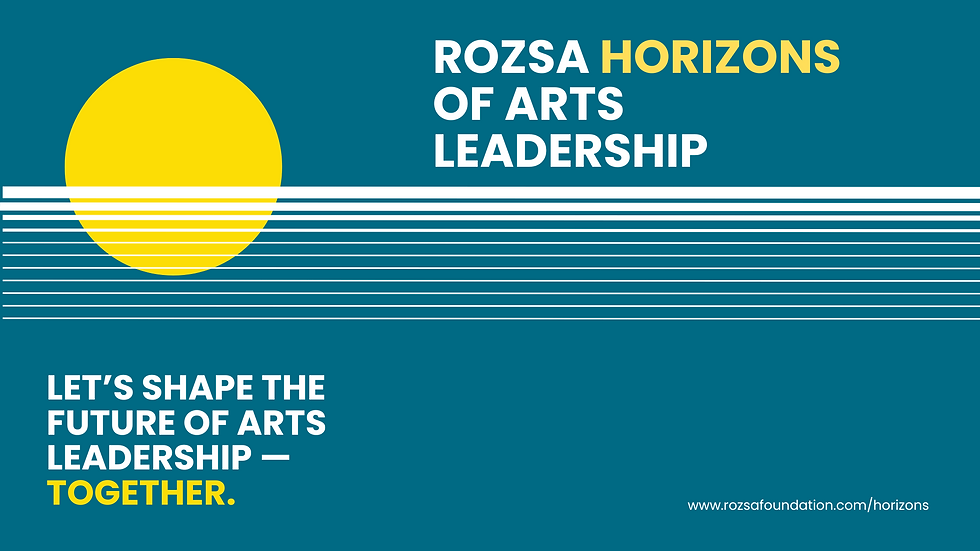Reconciliation and the Arts: RAMP Session #1
- Rozsa Foundation
- Dec 7, 2020
- 4 min read
Updated: Mar 30, 2021
by Lisa Mackay

The 2020-2021 Session of the Rozsa Arts Management Program (RAMP) opened with a session on reconciliation and the arts led by sibling duo Jacquelyn and Hunter Cardinal of the Naheyawin agency. In the words of Hunter Cardinal, “Naheyawin is a consultancy working to help organizations and communities build capacity for abundance, kindness, and reinvigoration of the spirit of treaty by implementing indigenous principles into everyday business practices and processes. We often say that we invite others to peer through our indigenous lens with us and feel empowered to travel the bridges to the places we dream of going and in that journey, transform into the people we believe we can be.”
In their pre-session work, participants were sent readings about Self-Locating, which is the practice of acknowledging the lens with which we see the world, and making it visible for ourselves and others. It can also be an Indigenous practice and way of introducing themselves - they give their name, family name, the land they are from, and the stories they carry, which immediately provides context for future discussion and can establish relationships. Receiving this tool up front will hopefully impact participants’ ensuing experiences, both in RAMP and in their professional life outside the program.
Establishing the groundwork for positive participation in reconciliation is at the core of Naheyawin’s work. As Jacquelyn wrote in a blog post, “In a conversation with an elder when I was in my late teens, I was told about a concept of “bridges” between worlds that connect Indigenous and non-Indigenous peoples. He explained, those bridges are not meant to be a place for Indigenous and non-Indigenous peoples to meet, shake hands and then return to respective sides. They are meant to be travelled by everyone, crossed back and forth into the familiar and the unfamiliar in order for true relationships to be forged. He stressed that learning to walk those bridges once again in that good way is one of the great challenges of our time.”
“At Naheyawin,” she continued, “We are honoured to recognize that we have inherited these ancient bridges, and that it is our calling to be companions on them, guiding those who have not walked them to see the true possibilities of the relationships we seek to build.” The Cardinals were excited to have been invited to bring this work to the RAMP participants. “When I think of the artists I have worked with,” said Jacquelyn, “there is an unarticulated desire to plug in, to get in the mix, to make a difference, but an uneasiness around knowing how to enter the conversation. We want to invite them in, and help them feel at home in an inherently uncomfortable situation.”
Jacquelyn and Hunter opened their presentation with a thorough background on the perspective they as sakāwithiniwak (Woodland Cree) bring to the table, their creation story, and the concept of Tatawaw, or “there is room” which they explained meant that there is room for all of us in this circle, to continue learning, make mistakes, and ask questions. Having this knowledge and context helped participants follow their subsequent synopsis of Indigenous/Non-Indigenous historic relations and treaty agreements in Canada with a wider understanding of those involved. Their delivery was deliberately easy-going, casual, and lighthearted to set everyone at ease. “There is so much work to be done,” Jacqulyn subsequently explained, “and none of it can happen if anyone is coming from a place of shame.”
Feedback from participants was grateful and enthusiastic. “[This session] provided a context for reconciliation that I haven't heard in the past,” wrote one person. “To have that centred from a more wholistic Indigenous perspective was wonderful.” “[I] thought their session was extremely loaded with impactful information and nuances from intergeneration knowledge,” wrote another. “I am humbled to be a forever student and learner of Indigenous histories and perspectives as so much [of it] is lived vs taught.” Importantly, the participants felt that much of the information provided in the session was relevant to their present work and would inform their future decisions. “Following this session, I began to think of ways to decolonize my language and systems,” noted one commenter. “How can I be more empathetic and respectful of the communities my work serves to impact?”
Following the session, Geraldine also contemplated the role of the arts to move reconciliation forward. “We know that residential schools were created to take the "Indian out of the child" and that resulted in a loss of language, culture, customs, connection with land, traditional ways of living,” she mused . “Truth and Reconciliation Commissioner Murray Sinclair states that residential schools were an act of cultural genocide. How can the arts & culture which was taken away from Indigenous people be used to heal, revive, commemorate, explore, and "call into" as Jacquelyn and Hunter phrased it the institutions and systems of the past that are impacting us in the present so that we can move forward?”
It is questions like these that excite the Cardinals. “Providing this information and outlook is, for us, a functional solution to a messy, iterative process,” explained Jacquelyn. “I feel that this is a conversation between and about us, as in everyone together at the table. We all need to have ownership and agency in discussion, and above all a curiosity about each other. As Murry Sinclair has said, it took us seven generations to get to this place, it will take several more to turn it around. So I feel no urgency,” she laughed. “I consider sessions like these simply packing what we need for a long journey.”






Comments